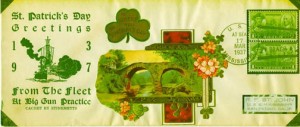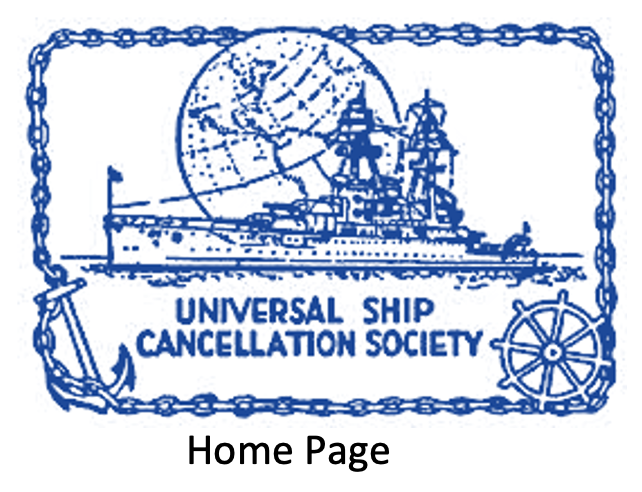USS Mississippi – St. Patrick’s Day
By Steve Shay (L-10,821)

March 2005 Cover of the Month
Henry Stinemetts (USCS member 1103) prepared covers marking holidays and historical events by combining printed cachets with paste on labels and paper. Sometimes the entire envelope would be covered with silk. The stamps were usually chosen so that the color would accent the occasion being marked. Sometimes the printed cachet would be from another cachet sponsor; he is known to have decorated envelopes with Walter Crosby photo cachets and a Sarah Litton thermograph design. He often used #10 size envelopes, presumably because these gave him more room to work with though he also produced covers using #6 envelopes. His covers were probably one of a kind due to the combination of labels that were used.
This cover was prepared to mark St. Patrick’s Day in 1937 and was postmarked on the battleship USS Mississippi. The postal clerk did his best to liven up the Type 3 cancel also. Note the green canceling ink, “At Sea” locator in the dial and the killer bar slogan, “Erin Go Bragh” (Ireland forever.) The cover is addressed Ray St. John (USCS member 1376) stationed on the USS Mississippi who also sponsored covers. Ray would have worked with Henry to have this cover serviced. The large label in the center of this envelope was not added after the postmark. Examination under glass shows the cancel being interrupted by the raised portion of the label. Note the folded paper covering the corners, the paper matte the stamps are covering and even the matte behind he address label. The cachet on this cover, featuring a battleship with cage masts firing a broadside is a Stinemetts design.
The 2 cent franking on this cover is 1 cent under the correct postal rate, a sure indication that this cover never went through the mail. Other Stinemetts covers contain overfranking; 11 cent postage was used on his 1936 St. Patrick’s Day covers. (The 11 cent Rutherford stamp was also green.)
Stinemetts is known to have prepared St. Patricks’s Day covers for 1935, 1936, 1937 and 1940. Because of the limited production and unique design for each of these covers, they are prized by collectors.
